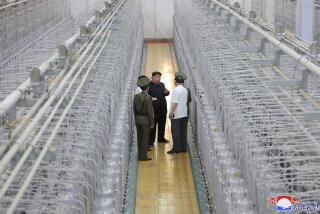North Korea enrichment plant no surprise to U.S.
- Share via
Reporting from Seoul and Washington and Santa — The U.S. special envoy for North Korea on Monday sought to downplay revelations that Pyongyang is building a new facility to process uranium that can be used in nuclear weapons.
State Department special representative Stephen Bosworth met with South Korean Foreign Minister Kim Sung-hwan, later telling reporters that the U.S. has been monitoring construction at North Korea’s main Yongbyon atomic complex.
“This is obviously a disappointing announcement. It is also another in a series of provocative moves” by North Korean leader Kim Jong Il, Bosworth said. “That being said, this is not a crisis. We are not surprised by this. We have been watching and analyzing [North Korea’s] aspirations to produce enriched uranium for some time.”
North Korea recently revealed to a U.S. nuclear expert that it was building a sophisticated enrichment operation and had completed 2,000 centrifuges that U.S. officials warn could be used to enrich uranium for nuclear weapons. The claims are backed by new satellite images that show ongoing construction at the site.
Siegfried Hecker, a former director of the U.S. Los Alamos Nuclear Laboratory, wrote in a report on his visit to the Yongbyon nuclear complex that he was allowed to visit a small, industrial-scale uranium enrichment facility, which he said had been secretly built at stunning speed.
Though it was not clear why officials had allowed Hecker and two other U.S. experts to tour the facility, some characterized the move a North Korean ploy to improve its position in talks aimed at convincing the regime to drop its nuclear ambitions.
On Sunday, Adm. Michael G. Mullen, chairman of the Joint Chiefs of Staff, said the reports from the two U.S. experts validated longstanding concerns about the communist nation’s intent to develop an arsenal of nuclear weapons.
“It’s North Korea continuing on a path which is destabilizing for the region,” Mullen said on CNN’s “State of the Union with Candy Crowley.” “It confirms or validates the concern we’ve had for years about their enriching uranium, which they deny routinely.”
He said reports that North Korea is building a plant to enrich uranium, which could be used for producing nuclear power or bombs, are consistent with the country’s “belligerent behavior.” He also cited the sinking of a South Korean warship in March, which killed 46 sailors. North Korea denied it was responsible for the vessel’s sinking.
Defense Secretary Robert M. Gates said Sunday that the disclosure confirms suspicions that the government in Pyongyang had a secret enrichment effort underway as part of a strategy to expand its nuclear arsenal.
Pyongyang conducted nuclear tests in 2006 and 2009 and is believed to have a small number of nuclear devices.
“An enrichment plant like this, assuming that’s what it is, obviously gives them the potential to create a number more,” Gates told reporters in Santa Cruz, Bolivia, where he is attending a meeting of defense ministers.
Still, Kim, the South Korean foreign minister, echoed Bosworth’s call for calm, calling the facility “nothing new.”
Hecker said North Korean officials acknowledged they began building the centrifuge facility in April 2009, and finished shortly before the American’s visit earlier this month.
In his report, the scientist said the new rectangular facility, believed to include a 25- or 30-megawatt light-water reactor, appeared to be designed to produce electricity. He added, however, that the uranium enrichment facilities “could be readily converted to produce highly enriched uranium bomb fuel.”
Bosworth is on a weeklong trip for talks with officials in South Korea, China and Japan on the North Korean developments. He said U.S. officials “do not at all rule out the possibility of further engagement with North Korea,” referring to the moribund six-party talks.
He later added that “I do not believe in engagement just for the sake of engagement or talking just for the sake of talking. I would never declare any process dead. It’s still breathing, and I still think we have hope that we’re going to be able to resuscitate it.”
He called it “fundamental” that the U.S. government “deal with this in close coordination with major countries.”
john.glionna@latimes.com
Glionna reported from Seoul, Puzzanghera from Washington and Cloud from Santa Cruz. Paul Richter in the Washington bureau contributed to this report.
More to Read
Sign up for Essential California
The most important California stories and recommendations in your inbox every morning.
You may occasionally receive promotional content from the Los Angeles Times.












